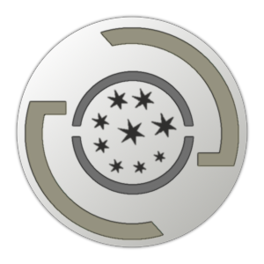Zoner Alliance
We would like to encourage any outside agencies who wish to conduct agreements to contact us on a diplomatic channel.
Zoner Alliance
- Coordination of global Zoner issues
- Verification the usage of Zoner technology
History
Zoner History
| Zoner Alliance | |
| Origin | Zoners |
| Alignment | Neutral |
| Profile | |
| Date of founding | 818 A.S. |
| Founder(s) | Zoners |
| Current leader(s) | Alliance Committee |
| Base of operations | |
| Primary role | |
| Coordination of global Zoner issues | |
| Secondary role | |
| Verification the usage of Zoner technology | |
| Table of contents | |
Since the beginning of human settlement in Sirius, Zoners were perceived as people who decided to resign from the guaranteed safety of the Houses. They set out to live their lives in the more dangerous, but also auspicious environments of the Edge Worlds, which were collectively known as The Zone. The migration of former House citizens into these territories was akin to the old Earth’s “Exploration of the Great Frontier.” Men and women from a variety of backgrounds brought what little they could carry into unknown voids of space. These Zoners ranged from mere adventurers to the socially disadvantaged; from prisoners to corporate tycoons. But no matter what reasons drove people out of the relative safety of the Houses, every one of these Civilians wanted to start a new life.
One can imagine how painstakingly difficult it was for the first Zoners in the Edge Worlds. They had to abstain from the comforts provided by well established infrastructures of their former homes, so the only way to begin a new life away from the developed parts of Sirius was to sell rare goods found in the Outer Systems to House corporations and criminals alike. Trading became crucial for their survival. They traveled to every corner of Sirius in order to exchange goods, and in the process ignited the first wave of Zoner Immigrants. As traders from the Edge Worlds emerged, now flying under an Independent banner, they attracted a flood of civilians who were largely impressed by the Zoners’ freedom and prosperity. The news of Zoners spread through Sirius attracting more and more people - craftsmen, veterans, scientists, artists and criminals - many of whom changed their identity and tore down all connections to their respective communities. Their new life had to be tightly bound to a neutral attitude towards political plots and struggles, which gave them the necessary security to travel wherever they wished. Some historical evidence also suggests that the Zoners’ separatist approach toward all factional organizations indirectly resulted in the acclaimed neutrality they maintain to this very day.
The Zoners’ primary focus was civilizing the harsh environments they sought refuge in, but they were still too few to build solid infrastructures in order to colonize inhabitable planets, so they started to build space stations and small habitats. Losing lots of their ships exploring the Edge Worlds they learned to be cautious and they learned to value life more than anything else, at least their own. Living in systems with a vanishing density of population they also got used to relying on themselves, preferring independence, personal responsibility and freedom, but they also had to learn to cooperate with each other, just slowly at first, as their will to survive left no other choice to them. These loose cooperations lead to the founding of little communities moving from location to location in order to find new resources and ways to improve their lives. Today it seems to be cynical, but they lived like Nomads.
Many years passed, and some of these scattered communities grew slowly but steadily, still attracting more and more people. They claimed abandoned stations, like Freeport 2 in 650 A.S., or built new marketplaces, like Freeport 1 in 738 A.S., at junctions of well-known trade routes to ensure the better provision of daily needs. The first communities settled on habitable planets (Planet Erie in 761 A.S.), and other communities, led by dropouts with scientific backgrounds, launched prototypes of the now fabled Juggernauts into space which were supposed to serve as colonial holds, Transports, exploring vessels and support facilities. These ships were also designed as ships of war , although they where never used in this role. They had the resources to build them, so they did.
But Zoners had neither enough time, nor a real need to concentrate on developing military power, although they have always been able to develop technology to be among the best Sirius has ever seen. Their love for freedom and individual occupations as well as the wide spread areas they were living in never allowed the foundation of a common military organization. They preferred to spend their income for further scientific advance, conforming with their curious nature, personal luxuries and new ways of colonizing and perhaps exploiting the Edge Worlds, and most people of Sirius appreciated the Freeports as bastions of freedom where commodities could be traded and information gathered freely and unmolested by House authorities. The first Zoner bases did not even have local security personnel, so most Zoners learned quickly to balance opinions, and to abstain from political interference in order to diffuse conflicts at the initial source of the problem. This neutral attitude and indifferent behavior towards almost everyone founded their reputation as good diplomats. The first noticeable common effort of Zoners to sustain their neutral position is their neutral role in the epic conflict between the Corsairs and the Outcasts.
Beside their neutral attitude towards everybody Zoners had to establish reliable trade contracts as well. The first of this kind was established with the Gas Miners Guild due to each side's satisfying experiences over the years, finally leading to an alliance that is flourishing until today. A second and very delicate alliance has also been forged, which is not completely undisputed among Zoners today: In the prelude of the Nomad War, Zoners were among the first who encountered specimen of these aliens. Never being involved into serious conflicts, thus unable to find quick solutions to this new threat, and feeling secretly responsible for the alien's spreading - it was a Zoner who was to be contaminated first - they appreciated the secret work of the legendary Liberty renegade Casper Orillion. The Zoners had no choice but to support his work, called The Order, with logistics, financing and intelligence, and due to the fact that The Order was able to achieve a temporary victory against the Nomads, this alliance has lived on until today developing into a mutual exchange of technology routed through intermediaries in the enduring fight against these aliens.
Today the Zoners and their reputation are famous throughout Sirius. Some might even say infamous, depending on their point of view. Zoners are still struggling to reconcile their political neutrality with their desire for individual freedoms, but their answers to this struggle are embodied in groups like the Temporary Autonomous Zoners and new organizations, the Omicron Supply Industries and the Zoners Trading Consortium, as well as the uncounted free-spirited individuals of the Zoner Union of Independents journeying under the Zoners flag, all together organized in the Zoner Alliance. Things are still changing in Sirius of course. The competition for resources is continuing, and the Houses are engaged in power plays with each other. The great war between Corsairs and Outcasts lasts, while the descendants of the long lost colonial ship Gallia have been found again. Almost forgotten is the alien threat, but even Nomads have learned from their defeat preparing their retaliation. It seems that Sirius is subjected to strong emotions that today's Zoners cannot ignore, but they are well prepared to face new challenges.
Alliance History
Zoner Alliance Constitution
The factions of the Temporary Autonomous Zoners (TAZ), the Zoners Trading Consortium (ZTC) and the Omicron Supply Industries (OSI) announce hereby the formation of the Zoner Alliance. The Zoner Alliance will be the main responsible body managing all negotiations and trade agreements with factions and houses, outside of the alliance, which will affect all members. Individual agreements affecting only one faction or group can be handled by that respective faction or group. Any Zoner faction or independent Zoner can join the ZA. Independents are asked by this announcement to form a group called the Zoner Union of Independents (ZUI) and to appoint one of their members as representative.
Here is how the ZA will function: The item that comes before the ZA will be placed before the representatives of each member group who will then have to set an amount of time to debate the matter in each group. Then each group will come to the recommendation how their representative has to vote on their behalf. Finally, all representatives will come together again and make a quick discussion by casting their vote for their groups. In the interest of speed, scenarios could be discussed before hand so no discussions would be needed just voting by the representatives. Nevertheless each group is responsible to find its own modus operandi to achieve best results.
Structure of the Zoner Alliance
1. Body Member of the Zoner Alliance: Group
- Each member - a group - makes its decisions for itself.
- Once a decision has been made the faction can decide whether to try encompassing equal bodies into the motion or project, or not.
- Scope of responsibility: Every issue which is not concerning general Zoner issues or including unclaimed Zoner spaces.
- Each faction is asked to implement a kind of democracy, visible or not, to prevent the development of totalitarian hierarchies.
- Members of any faction cannot have political rights or influence in more than one faction.
2. Zoner Alliance Body: Alliance Committee (AC)
- Allowed groups are either the officially registered Zoner factions, the ZUI, or unregistered Zoner groups operating as clans.
- Voting: Each body member has one seat. Each seat has one vote. The registered factions and the ZUI have the ability to cast a veto.
- Scope of responsibility: Global Zoner issues, policies, relations.
- Security Issues: The Alliance Committee will coordinate with each member the deployment of security and defense forces. Each member will be assigned to an area of responsibility, if available and possible.
3. Membership New groups can apply for membership and then must be approved by a majority vote by the Alliance Committee. New Independents must be accepted by the ZUI for membership. Zoner clans must have at least 6 members to be considered, with less than 6 members they apply to the ZUI and work within that member body until such a time as they have the required members count. Alliance members can be dismissed from the ZA by the complementary remainder of AC representatives voting unanimously. Individual Zoners can be removed by the ZUI itself or by a majority votes in the Alliance Committee.
4. Membership Responsibility All members have chosen to become part of the ZA. Each individual of each member is required to participate and assist their representative by voting, in a manner that will put their best interests forward. Each representative is charged with the responsibility of voting, in the manner that best suite the interests of his or her group. The Alliance Committee is in charge of forwarding the ideal and morals of the ZA and Zoners as a whole.
5. Nonmembers Nonmembers are not held to any treaty, deal or policy that is put forth by the ZA. Nonmembers are also not going to receive any protection if they violate any treaties or agreements or break any policies put forth by the ZA. Nor will they receive any protections by the ZA security forces if they are found breaking ZA policies, treaties or trade agreements.
Decision Making and Voting
Each faction group is charged with determining how they will choose and direct their representative. The representatives will then come together and lay forth the concerns or points brought to them by their group. Discussions will be limited to 48 hours and Alliance Committee deliberations will be limited to 48hours, followed by a vote. If a specific discussion cannot be met within the time limit, the Alliance Committee can approve an extension on the time for deliberations so the matter can be resolved properly.
Treaties and Trade Agreements
The Alliance Committee will appoint one person to be the negotiator for each treaty or trade agreement talk. The negotiator does not have to be a member of the Alliance Committee. Once the negotiator is chosen, they will be the only one allowed to conduct the talks. The Alliance Committee can remove a negotiator by a majority vote, or assign additional envoys to assist. Members agree not to break into or interrupt any talks being performed by the negotiator.
Foreign Contacts
If any Non-Zoner faction contacts the ZA the according member must inform the Alliance Committee about this contact when common Zoner issues, policies or treaties are concerned. An Alliance Committee representative or an assigned envoy will step into contact the Outside faction / Agency then regarding their request, and present it to the ZA with any recommendations afterward allowing the members to enter their processes of decision making.
Policies
Any member can bring up ideas for new policies. The Alliance Committee will then decide if the idea merits discussion. If the majority of the Alliance Committee agrees then it will be released to the member groups for discussion.
Voting
Voting will be handled in the open for all members to see. Once cast votes are final. Alliance Committee members can not abstain from votes. The Alliance Committee will then collect all votes and to publish each in public in one post including a final statement addressing possible consequences.
Proxies
In the case of absences of representatives during a vote, the Alliance Committee can urge the according group to select a temporary representative for that vote.
Veto power
Registered factions and the ZUI have the ability to veto any decision passed by the Alliance Committee. If an item is vetoed it will be brought back to deliberation to see if an agreement can be reached. Once deliberations are done a second vote on a resolution will be called. If the resolution is passed with no less than a 2/3 majority the Veto is over turned. If the resolution can not reach a 2/3 majority then the veto stands and the item is considered defeated.
Member Bodies
| Group | Description |
|---|---|
Error creating thumbnail: Unable to save thumbnail to destination
|
Temporary Autonomous Zoners The Temporary Autonomous Zoners are a group of independent and libertine Zoners who can mainly be found in their home system, Baffin and in Omega-49. |

|
Zoners Trading Consortium Consortium of Zoners with various occupations who can mainly be found in and around their home system. |
| Omicron Supply Industries Zoner enterprise bringing life to the outer reaches of Sirius, operating from their headquarters Freeport 10. | |

|
Zoner Union of Independents Council of Zoner independents. |

|
Zoner Ore Extraction Inc. Zoner enterprise involved in mining ore in selected places who can mainly be found between their home system Baffin and their prospecting sites. |
Zoner Union of Independents
Announcement, Explanation, and Registry:
Our role within the ZA will be to represent the interests of Zoners who are not affiliated with a major Zoner faction yet wish to be associated with the Zoner Alliance.
Political Procedures: The representative to the Zoner Alliance shall by me at first, and I shall stay in this role until we have at least five members. The Representative shall vote according to the will of the members of the ZUI at the ZA, and must adhere to the membership requirements at all time. The Representative shall furthermore refrain from voting in ZUI votes except during recall elections, membership revocation votes, and to break ties as described below.
- For subsequent elections, there shall be the following procedures:
|
1) A simply majority of ZUI members must vote for a recall election within 48 hours of the first call to vote. Any member may call for a recall election. Each member who votes for a recall election must nominate at least one viable successor when they vote for the recall election. The incumbent chair will automatically be entered into any recall election if he/she so chooses. 2) After 48 hours have passed, if the recall vote passes, the sitting Representative will begin taking votes. Voting will last for another 48 hours. 3) If one candidate has the votes of a simple majority of the ZUI, then he becomes the Representative immediately when the 48-hour voting period ends. 4) If one candidate does not have the simple majority of the ZUI, then a runoff election between the two most voted-for candidates will ensue for another 48 hours. If more than one candidate is tied for the second place, any candidate that has tied for second place will qualify for the runoff. 5) In the case of a runoff election, the candidate with the most votes wins. If there is a tie, the Representative shall be the candidate who is tied for the most votes who has been a continueous member of the ZUI for the longest amount of time. 6) The second place candidate shall serve as vice-Representative, and will act as Representative on a temporary basis if the Representative is unavailable for an extended period of time (>7 days). |
- For voting on ZA issues, the following procedures shall be adhered to:
|
1) The Representative will initiate a vote. 2) Members will have 48 hours to vote on the issue at hand. Members are encouraged to propose alternatives if they vote against a measure, but may not initiate a new vote at that time. 3) The option with the most votes shall decide the vote of the ZUI Representative at the ZA. 4) In the case of a tie, the Representative shall decide for himself between the options that were tied. |
- For voting on ZUI procedures, the following procedures shall be adhered to:
|
1) A member will suggest a new procedure or to edit or expunge an existing procedure, and submit it in written form to the Representative. 2) The Representative shall respond to the request within 48 hours. If the request is denied, he/she will provide the reason for the denial. If the request is approved, he/she will initiate a vote on the matter. 3) The vote shall last for 48 hours. If the measure receives a simple majority, the measure shall pass. If not, it shall not pass. In case of a tie, the Representative shall decide. |
- For revoking Membership, the following procedures shall be adhered to:
|
1) The Representative shall openly announce the individual to be removed, and why. In cases of inactivity after one month or more, the individual shall be removed automatically. If this is not the case, then proceed to step 2). 2) The Member being voted upon shall have 24 hours to provide a statement to defend himself if he so chooses; other members may argue for either side. 3) After 24 hours, the Representative shall initiate a vote. 4) After 48 hours, the Representative shall end the vote. The side with the most votes wins. If there is a tie, the individual shall remain a member. |
Membership rules: Members must not have any affiliation with any faction otherwise represented in the ZA, and must not be themselves members of the Council of Zoners. Members must submit to the rules of the ZA. Members will work to maintain good relations with other Zoners and their neighbors and post in the ZUI channel at least once per month.
Membership will be granted and revoked by the Representative and the ZUI members on these and only these criteria. Members will not be removed for simply voicing an opposing opinion in a respectful and orderly manner.
Membership
To request membership, please add your name and home station to your application .
Zoner Defense Force
Zoner Defense Force History
The idea of a Zoner Militia was first raised by a former Bretonian Armed Forces Admiral Sir Charles Pole back in 797 A.S. He had recently retired and adopted the Zoner way of life, he realized that Zoners could be exploited. Zoners had placed too much trust in other people. In 798 A.S., Sir Charles Pole, with enough funding from his own bank and that of other wealthy Zoners, he proceeded to convince Zoner leaders that Zoners would require security, as it was common to see a Zoner trader killed by a pirate because he/she did not have enough cash to pay the tax, or were simply unwilling. Zoner leaders reluctantly accepted Sir Pole’s plea, and he began a long process in training volunteers, with help from a legendary mercenary group back in those days, known as the Koensayr Guardsmen.
In the first few centuries after Sirius was settled by mankind, Koensayr was a large manufacturing firm devoted to producing high quality materials for star ship construction. The rise of piracy forced the company to form its own security division. As time ran its course the company slowly died off. The Guardsmen however persevered and became a small but highly successful and famous mercenary group. They eventually left house space and joined the Zoner movement in the edges. The entire group was hired by the new Zoner Fleet Admiral, Sir Charles Pole to train Zoner pilots in 798.
In 800 A.S. when Freeport 7 was destroyed the Guardsmen paid dearly. 90% of their force was aboard station when it went up along with the newly trained Zoner Fleet. All but one of their vessels were docked or moored to the station and thus lost. All that survived was a single Fearless destroyer, Arc Hammer, which was under manned. Sir Charles Pole, who survived the attack, lead the remaining Koensayr Guardsmen, and by random chance, they encountered the then unknown and mysterious Order. Seeking vengeance for the loss of their friends they aided the Order in its mission. At the Battle of Omicron Minor their vessel was severely damaged, retreating to Omicron Theta, the vessel was crippled and set adrift. The surviving crew put themselves into stasis hoping to be found.
In 817 A.S. a convoy of OSI, ZTC, and TAZ trade vessels stumbled upon the derelict Arc Hammer. The crew was revived and the Arc Hammer crept back to Lividia. Among the personal of the convoy was a young retired BAF commodore name Francis West. Now face to face with men and women who gave so much of their life to protect what Zoners hold dear, he decided to help them reform the Koensayr Guardsmen. Charles prediction that Zoners would be exploited became true when he found that the Queen Carina’s Privateers had began hostilities against Zoners for providing humanitarian support to the Corsairs. Facing a new division within the Zoner community, with one side being the Council of Zoners while the other being the Zoner Alliance, along with the numerous independent Zoners, Francis West, along with the now aged Sir Charles Pole, argued that a Zoner Militia would not only serve to defend Zoner interests, but provide unity and order within the Zoner community, perhaps even preemptively stopping a Zoner civil war. OSI, TAZ, ZTC, and the CoZ all agreed to help fund this new Zoner militia, which from this day on would be known as the Zoner Defense Force.
Zoner Defense Force Structure
High Command
High Command consists of the Grand Marshal and the four operational Marshals; the Marshal of the Omegas, Marshal of the Taus, Marshal of the Omicrons, and Marshal of the Nomad Control Task Force. The Grand Marshal is the commander in chief but his orders can be over turned if the majority of High Command disagrees with him. High Command is based out of Sparta Station. Each Marshal has his own headquarters at a Zoner station of his choice in his area of operations.
Civilian Oversight Committee
A Committee in which each OSI, TAZ, ZTC, and CoZ each send one rep. There is a seat for an independent Zoner also; one who has no affiliation with the four primarly Zoner factions and will be filled via popular vote. This committee holds no sway over politics. It is simple there to provide a place for the civilian factions to voice their views, ideas, thoughts and such to ZDF High Command. It is also where HC can request funding as the COC is the body that approves the funding for the ZDF.
Naval
The ZDF Navy patrols the space and systems in which Zoner bases/planets or Freeports exist. Their main job is to enforce the No Fire Zone (NFZ) within 5K of every Freeport as well as escorting Zoner traders and civilians across Zoner territory. They are also ready to be deployed in Omicron Minor or Omicron Gamma if either of these systems are under attack by Nomad forces, and if they are given permission to do so by Order High Command or the Council of Elders respectively.
Nomad Control Task Force
The Nomad Control Taks Force (NCTF) was created in order to counter the growing Nomad threat in the Omicrons and Omegas by assisting Order operations against Nomads in the area. The NCTF also roots out Nomad infected individuals within the Zoner community and neutralizes them. Marshal Lehon Kaine leads the NFTF from the bridge of the Arc Hammer; he reports only to the Grand Marshal. He works with the Order to coordinate the operations against Nomads together. The NCTF is a small force almost all of which are Koensayr Guardsmen or their descendants. They are the only members of the Defense Force allowed to use Order tech. Only Lieutenants and above may serve in the NCTF.
Known Bases
| Base | Name, system and description | Owner |
|---|---|---|
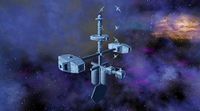
|
Ames Research Station, Kepler Ames Research Station was originally constructed in 677 A.S. by Deep Space Engineering, to investigate the strange dark matter clouds that were in the eastern areas of the system, and also to study the dark matter storm that was scheduled to pass through the system in 684 A.S. As it happened, the storm entered Kepler 104 years later than it was expected to, destroying the old trade lane that passed through the western area of the system and rendering it extremely dangerous to travel through. Deep Space Engineering incurred heavy financial losses during the construction of the new lane to the Shikoku Jump Gate, and as a result their operations on Ames were scaled back almost completely to the point of abandoning the station. Around 760 A.S., a group of Zoners moved onboard the station, slowly taking over previously vacated habitation decks and science laboratories, bringing the station back up to operational status. In exchange for keeping the station running and use of the repair facilities onboard, DSE agreed to give the Zoners complete ownership of Ames. Since then, the Zoners have run it as a Freeport and despite DSE's occasional complaints about allowing even Xenos to dock, it has been run profitably and has become a convenient stopover for anyone passing through the independent systems between Kusari and Liberty. |

|
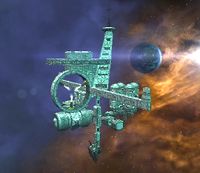
|
Bethlehem Station, Pennsylvania Bethlehem is a Zoner installation built in 780 A.S. Unlike larger Philadelphia, it remained independent from Liberty civilian authorities after the House took Pennsylvania under its control. |

|
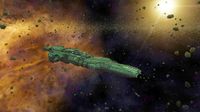
|
Carrier Tarrafal, Bering The Tarrafal started life as an experiment by the Zoners of Bethlehem, where it served as a mobile mining platform in the Helium fields of Pennsylvania. Fielding a fleet of mining ships, it served as a drop off and collection point for the extracted gas. After Bering quietly fell to Pirates and other unlawfuls, with the Freeport abandoned to the new owners of the system, Bethlehem experienced an influx of refugees seeking to rebuild their lives on the nearest Zoner station to their former home. |
|
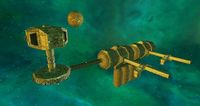
|
Corfu Base, Omicron Theta Bethlehem is a Zoner installation built in 780 A.S. Unlike larger Philadelphia, it remained independent from Liberty civilian authorities after the House took Pennsylvania under its control. |

|
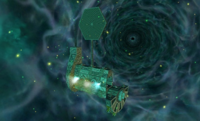
|
Corinth Research Station, Omicron Kappa Corinth is the main research center of the Zoners, often visited by scientists of The Order. New Zoner equipment and weaponry is being developed here, using the latest technologies available in Sirius. Some of the best armor upgrades, as well as new ZT43-4 "Fury 4" Zoner Photon Blaster and ZT43-5 "Fury 5" Zoner Photon Blaster photon blasters, originate from Corinth. |

|
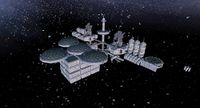
|
Freeport 1, Omega-3 Freeport 1 was built in 738 A.S., by a group of vagrants, wanderers and social outcasts that had left territories of the Houses in order to live beyond the rules and regulations enforced in the core systems. It was the first ever Freeport to be constructed, as the name clearly states, and it quickly gained popularity with the criminals, outlaws and others of a dubious disposition as a place to easily obtain supplies and repair their ships. Most of the criminals who visit Freeport 1 tend to be members of the Mollys or the Corsairs, although the occasional Red Hessian and Gaian are seen onboard. Over time, however, Freeport 1 has grown, with new cargo modules and habitation decks being constructed until the Freeport was barely recognisable from the small platform it started out as. Small ships are known to be constructed here, sold to both freelancers, criminals and other zoners, and although Bretonia has made irritated noises towards the Freeport, they have as yet left it alone, preferring to put up with the annoyance of criminals docking there to the unknown consequences that might otherwise occur by antagonising the largely peaceful Zoner society. |

|
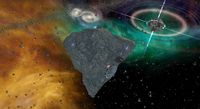
|
Freeport 5, Omega-41 Freeport 5 was originally build by the Independent Mining Guild (IMG), but the base was subsequently abandoned due to the intense radiation that plagues the system. A small, particularly dedicated band of Zoners moved in soon after and declared the base Freeport 5. Despite being shielded by a planetary fragment, the intense radiation requires a constant influx of Pharmaceuticals for both the Zoners and those travelers unfortunate enough to become afflicted with radiation poisoning. |

|

|
Freeport 6, Tau-29 Originally a loose assemblage of habitat modules intended to provide quarters for Deep Space Engineering crews constructing a Trade Lane through the system, the station was abandoned upon completion of the Trade Lane and eventually became home to the Zoners. The station was dubbed Freeport 6, and with the addition of a Synth Foods biodome, has become largely self-sufficient. Because of its strategic location in the Border World systems, it is a frequent way station for cargo runs by Bretonian and Kusari shipping companies, as well as a springboard for Independent Mining Guild (IMG) and Zoner expeditions. |

|
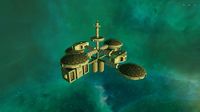
|
Freeport 9, Omicron Theta Freeport 9 is very nearly the only human population for hundreds of light years in every direction -- which is exactly the way the Zoners like it. Despite its location in a system filled with strange nebula and forbidding black crystals, however, Freeport 9 is a frequent stop for criminal organizations looking to buy Food from the Freeport's biodome, while Cryer Pharmaceuticals has shown an intense interest in the Alien Organisms that colonize many of the asteroids in the system. |

|
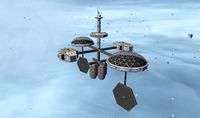
|
Freeport 10, Tau-37 Until Freeport 10 was established in 760 AS by a band of Zoners looking to establish an outpost as far from the colonies as possible, Tau-37 remained a virtually unexplored system at the distant edge of the Sirius Sector. Largely self-sufficient due to a Synth Foods biodome, the Zoners have continued the open-to-all tradition of the Freeports and frequently play host to members of the Independent Mining Guild (IMG) and Outcasts. |
|
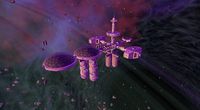
|
Freeport 11, Omicron Delta Freeport 11 is the new outpost built by Zoners in Omicron Delta. Strategically placed between Nomad systems and Corsair territory, Delta is an attractive system for criminals, explorers, bounty hunters and The Order. Although building biodomes in this far-away and dangerous place was very expensive, Zoners quickly started to make huge profits from trading food and oxygen. |

|
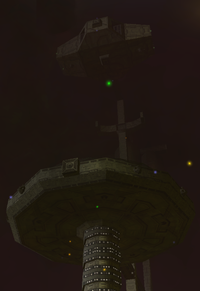
|
Freeport 14, Alberta Freeport-14 is the latest addition to the Zoner Freeports family. Located in the desolate and unexplored Yukon system, this station was literally built in the middle of nowhere in 815-816 A.S. Some of its inhabitants came from Kusari or Liberty; some are "Zoners within Zoners", a small group of people who prefer to live isolated even from their own brethren. The latter once settled in Messina Freeport, but were forced to leave it due to an excalating conflict between the Corsairs and the Outcasts. |

|
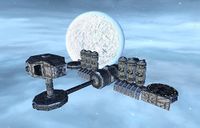
|
Lanzarote Base, Omega-49 Lanzarote Base was originally built as a base of operations for the Zoner expedition that charted the Omega-49 system and eventually settled Planet Gran Canaria. Meant to be a drop-off and loading point for the raw materials that were supposed to come up from the surface of Planet Fuerteventura, this purpose was almost completely abandoned when it was discovered that the planet below did not have significant resource value, except for large deposits of gold ore. Much of the support structure meant for handling these resources was dismantled in place, resulting in the debris field now surrounding the station. Currently, Lanzarote Base serves as an early warning station to detect ships coming in from the Dublin jump hole. It also handles and processes the automated shipments of gold ore from the mining operation on Planet Fuerteventura. |

|
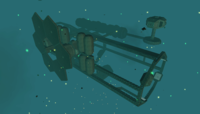
|
Livadia Shipyard, Omicron Kappa Livadia Shipyard is the major ship construction facility for the Zoners. This shipyard is the site for building a large number of different ships, including civilian fighters ranging from Hawks to Eagles, freighters and transports, and capital ships. Zoner Juggernauts and other battleships that originate from Zoners were built in Livadia. |

|

|
Planet Gammu, Omicron Kappa The icy world of Gammu was colonized by a group of deep space settlers several years after Primus, in 496 A.S. Few inhabitants of this inhospitable place did not know anything of radiation that plagued the planet's surface, much like on Primus. Of planet's 1400 initial population, more than a quarter was dead by 528 A.S. because of radiation. The colonists tried to evacuate the planet and almost succeeded, but fully loaded transports and escort ships were destroyed by a large Nomad fleet. Numerous service robots with enhanced artificial intelligence remained planetside and kept up two robotic plants constructed by the colonists. When Corsairs rediscovered the planet several hundred years later, the planet was filled with thousands of self-sufficient robots. |

|
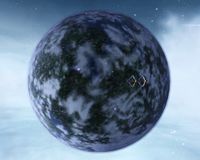
|
Planet Gran Canaria, Omega-49 Discovered more than 50 years ago by Zoners, planet Gran Canaria became their new hope for a peaceful life on a hospitable and oxygen rich world far away from house territory. However, as soon as a Jump Hole to Dublin was discovered in Omega-49, the Zoners realised that if the Bretonian Government gets to know about Gran Canaria, they might attempt to conquer the system. Mollys from Dublin also posed a threat for the Zoners' new home. Shortly after the Nomad War, the Zoners made a strategic decision to sell secret Omega-49 routes to the Corsairs in exchange for money and protection. The Zoners secured their bases in the Corsair zone of influence, including Freeport 9. Corsairs, in return, gained an alternative route to strike both Bretonia and the Mollys from where they least expected. Nowadays, more and more Corsairs settle on Gran Canaria; and they are known to unofficially station ships from the planet. Zoners also come to this planet from all over Sirius, leaving behind their Freeport homes. |

|

|
Pueblo Bonito, Baffin Pueblo Bonito was constructed by a mysterious Sect of Zoners who worshipped an ancient Terran Goddess. They modeled the base interior after the ruins of a lost tribe which once inhabited a western continent of Terra known as "Unistat". The ice covered asteroid that Pueblo Bonito has been carved into contains the similar cystal formations to the Goddess's Geode. Interestingly it has one natural cavern in the center shaped like an almost perfect pyramid. The Zoner Sect which inhabits Baffin has made this miraculous place a Temple to their Goddess, open only to members of their Sect. |
Error creating thumbnail: Unable to save thumbnail to destination
|
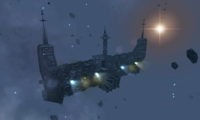
|
Sedona Station, Baffin Sedona Station is the collection point for the small proto-nomad "Scrubbies" discovered in the Devon Ice Cloud by a Zoner explorer. These fish-like organisms have the ability to consume inorganic matter, and convert it to organic compounds and breathable gases such as oxygen and nitrogen. Thus, they are valuable as self-contained "terraforming machines". |
Error creating thumbnail: Unable to save thumbnail to destination
|

|
Shasta Outpost, Baffin Shasta Outpost was built above the entrance to an immense hollow geode, which is lined with massive quartz crystal spires. The interior of the geode was found to have curative properties, as well as activating the "Chakras" of the human nervous system. The Zoner Sect which inhabits Baffin has made this miraculous place a Temple to their Goddess, open only to members of their Sect. |
Error creating thumbnail: Unable to save thumbnail to destination
|
Diplomacy
| Faction | Relationship | ||||||||||||||||||||||||||||||||||||||||
|---|---|---|---|---|---|---|---|---|---|---|---|---|---|---|---|---|---|---|---|---|---|---|---|---|---|---|---|---|---|---|---|---|---|---|---|---|---|---|---|---|---|
| The Order |
| ||||||||||||||||||||||||||||||||||||||||
| Gas Miners Guild |
| ||||||||||||||||||||||||||||||||||||||||
| Keepers |
| ||||||||||||||||||||||||||||||||||||||||
| Das Wilde |
| ||||||||||||||||||||||||||||||||||||||||
